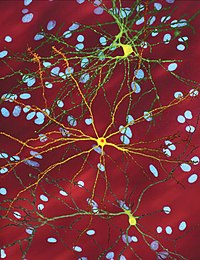
Photo from wikipedia
INTRODUCTION While airway clearance techniques (ACTs) are recommended for individuals with bronchiectasis, data suggests the use of and adherence to ACTs is poor. OBJECTIVE This study aimed to identify patient… Click to show full abstract
INTRODUCTION While airway clearance techniques (ACTs) are recommended for individuals with bronchiectasis, data suggests the use of and adherence to ACTs is poor. OBJECTIVE This study aimed to identify patient perceptions regarding ACTs, the barriers and facilitators to ACTs, and factors affecting adherence. METHODS A multi-center qualitative study using in-depth semi-structured interviews of individuals with bronchiectasis was undertaken. All interviews were audio recorded and transcribed verbatim. Data was analyzed using the thematic framework approach described by Braun and Clark. NVIVO™ 12 software assisted with coding and thematic analysis of the interview transcripts. Data saturation was achieved when no new common themes were identified. Findings were summarized into major conceptual themes. Participant demographic data was also obtained. RESULTS Twenty-four participants participated in semi-structured interviews. The main facilitators to using ACTs included a perceived health and quality of life benefit, a tailored approach to ACTs and the use of self-management strategies. Main barriers included lack of time and motivation, lack of access to resources, and a lack of perceived health benefit. A number of factors were identified by participants that may help promote adherence including combining and trialing different ACTs, receiving regular ACT reviews and education from physiotherapists, and having good social support. CONCLUSION To assist the personalized prescription of ACTs, these facilitators and barriers should be considered by clinicians to help promote adherence and improve patient outcomes.
Journal Title: Physiotherapy theory and practice
Year Published: 2022
Link to full text (if available)
Share on Social Media: Sign Up to like & get
recommendations!